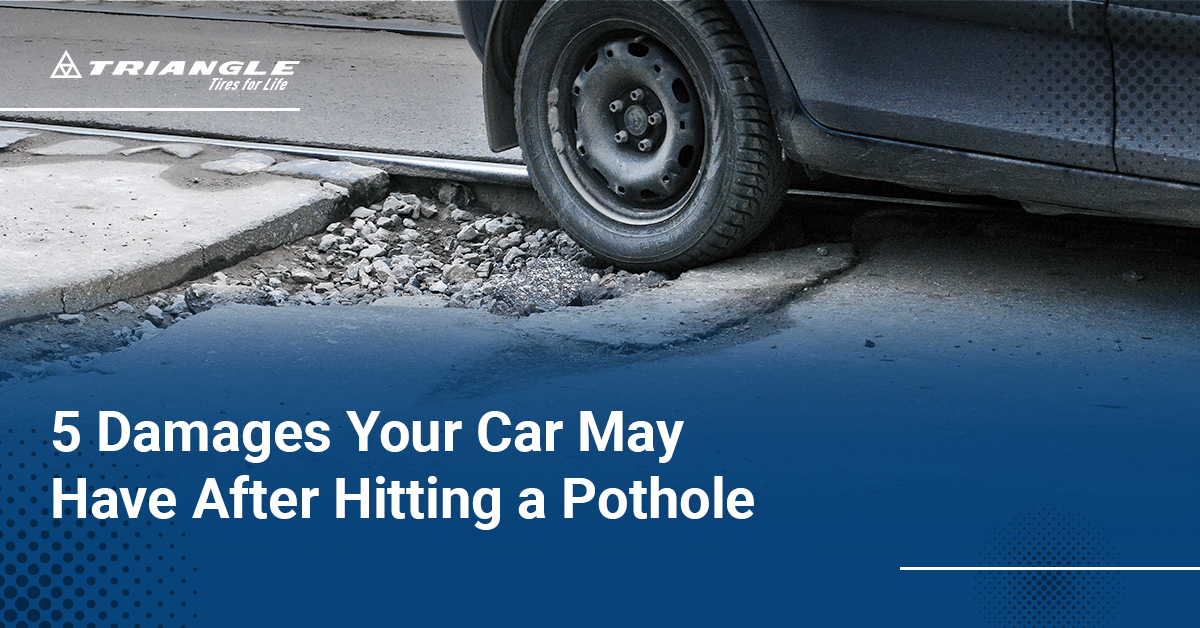
Drivers in the Philippines are no strangers to rough roads, even on main thoroughfares. The country’s annual typhoon onslaught often leads to cracks and potholes forming along roads, making rides bumpier and unpleasant.
Besides being a nuisance, hitting a pothole threatens you and your vehicle. You risk damaging critical components, making driving dangerous for everyone on the road. As such, it’s crucial to be aware of how potholes damage cars so that you can mitigate any harm and deal with the aftermath accordingly.
Which Parts of Your Car Are Likely to Be Damaged by Hitting Potholes?
Your car’s lower side, particularly its tires, wheels, suspension, undercarriage, and body, bears the brunt of the impact. Knowing how potholes break them can help you evaluate your vehicle when you become a victim of faulty roads.
Tires
Potholes and flat tires often come together. Impacts from sudden drops can cause tires to hit potholes’ sharp edges and rough surfaces, leading to blowouts and sidewall damage. Your tires may also develop bulges that compromise their structural integrity and increase the likelihood of blowing.
Getting high-quality tires that can reliably sustain impacts from potholes is best to minimize long-term costs. However, when they get damaged or punctured, it is best not to get them repaired or vulcanized as their structural integrity is already compromised.
Wheels
Sudden impacts can bend and crack your rims, undermining their airtight seals with tires and resulting in leakage and low tire pressure. It may also loosen hubcaps and expose wheels to dirt and debris, further damaging them. Potholes compromise your wheel bearings’ integrity as well, which, at best, can cause unwanted noise and vibration and, at worst, detach the wheel from the car.
In other cases, impacts can also misalign your wheel. The result is poor, unpredictable handling that could lead to fatal accidents.
Suspension
The purpose of your car’s suspension system is to absorb impacts and keep passengers secure. However, potholes can damage your car’s suspension and cause misalignment issues, which pull your vehicle in one direction. Excessive bouncing, squatting, and diving due to damaged suspension can also destabilize your vehicle on the road.
Undercarriage
Deep potholes can dent your car’s undercarriage and damage vital components. For instance, exhaust systems, mufflers, and catalytic converters scraping against potholes can result in dangerous fumes entering the cabin and suffocating everyone on board. Meanwhile, damaged oil pans cause leaks that might overheat and prematurely wear the engine.
Body
Potholes may scratch your car’s bumpers and side skirts. Even worse, the jolt from high-speed impacts can loosen and detach them from the body, becoming hazards on busy and low-visibility roads. In extreme instances, potholes can damage your vehicle’s frame or chassis, compromising its safety and integrity.
What to Do After Hitting a Pothole
After hitting a pothole, immediately get yourself and your car to safety by taking steps that can help prevent accidents.
Check your dashboard for warning lights
A lit-up dashboard is usually the first sign of trouble as it indicates how much your car suffered from the impact. For example, the Tire Pressure Monitoring System (TPMS) often lights up if potholes do a number on your tires. Meanwhile, a flashing Electronic Stability Control (ESC) light indicates steering or traction control loss. You may jot down the flashing lights for a professional inspection.
Listen for vibrations and weird noises
Next, turn down the radio and air conditioning to listen for irregular noises from your vehicle. You might feel out-of-place vibrations or hear something dragging on the road. Anything out of the ordinary may imply a problem needing immediate attention and solution, so listen closely.
Pull over in a safe location
If you notice anything amiss after hitting a pothole, it may be time to find a safe location to pull over. Pick a spot away from heavy traffic and pedestrians to inspect your vehicle without obstructions, then switch the hazard lights to alert other drivers. You may also use an early warning device for better hazard visibility at night and in low-light conditions.
Inspect the car for signs of damage
After pulling over, safely disembark the vehicle and investigate for visible damage. Check the tires for punctures and bulges, then the wheels for bends or cracks. Examine the bumpers and side skirts if they’re loose or falling off, and look underneath for leaks, loose parts, and other broken undercarriage components.
Call roadside assistance if necessary
If the car suffered significant damage and you can’t drive safely to a repair shop for further inspection, consider calling roadside assistance. They can assess the damage, do minor repairs, and tow the vehicle. Some even offer a ride to the nearest service center and guide you through the next steps.
Protect Your Car with High-Quality Tires
Hitting potholes is not uncommon when you’re driving on Philippine roads. As such, it’s crucial to know the damage they may do to your vehicle and the steps to take afterward. However, if you’re unsure about the car’s condition after hitting a pothole, always seek professional assistance from a mechanic for a worry-free drive after the incident.
Using tires built with high-quality rubber is an effective way to protect your car from pothole damage. Fortunately, Triangle Tires has a wide array of quality tires—from passenger cars and light trucks to heavy equipment vehicles—available for delivery at an affordable price.
Browse our tire catalog, or contact us to know how we can help you.